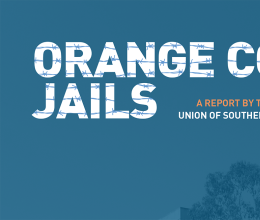Community Safety, Community Solutions: Implementing AB 109
California prisons face conditions so extreme that the U.S. Supreme Court has stepped in, ordering the state to take immediate steps to significantly reduce our prison population to comply with Constitutional standards.
The Problem: Over‐incarceration and High Recidivism
Today, the United States has 5% of the world’s population and 25% of the world’s incarcerated population. The state of California houses one of the largest prison and jail populations within the U.S. Despite extremely high state and local incarceration rates, California’s recidivism rate of 67.5% is among the highest in the nation. California prisons face conditions so extreme that the U.S. Supreme Court has stepped in, ordering the state to take immediate steps to significantly reduce our prison population to comply with Constitutional standards.
The Solution: County‐level, Evidence‐based Alternatives to Incarceration
Your county can be part of the solution. With the passage of AB 109 and subsequent amending legislation (“The 2011 Realignment Legislation Addressing Public Safety”), your county government assumes significant new corrections, reentry and community supervision responsibilities for people convicted of certain non-serious, non-violent felonies. Broadly speaking, realignment refers to changes in the assignment of program and fiscal responsibilities between the state and local governments. In the context of AB 109, realignment refers to the shifting of criminal justice responsibilities from the state prisons and parole board to local county officials and superior courts.
AB 109 realignment goes into effect on October 1, 2011. The state is providing funding to counties to offset some of the local costs realignment will bring. Each county is required to develop a realignment implementation plan, to be voted on by a seven-member committee of county officials and submitted to its Board of Supervisors. This Report will provide local government officials, service providers and the public with the information and tools needed to collaboratively develop successful realignment implementation plans.
Related content
Federal Appeals Court Requires Immigration Authorities to Consider...
October 3, 2017ACLU: Immigrant Detainees in Orange County Illegally Denied...
September 13, 2017Advocates Applaud Governor Brown and Chief Justice's Commitment to...
August 25, 2017ACLU SoCal Statement on OC Sheriff Sandra Hutchens’s Retirement
June 27, 2017ACLU Report Finds Inhuman, Violent Conditions in Orange County Jails
June 27, 2017